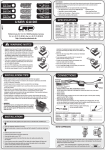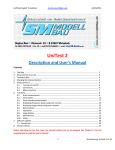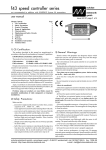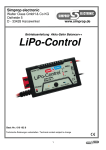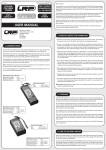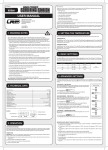Download USER GUIDE
Transcript
Order No.: 3 8A-6 -1 2 B EC 8515 Order No.: 53A-6 -1 2 B EC 3 8A-6 -1 2 B EC 8526 Order No.: 8537 Order No.: 8549 4000 Hz pulse frequency 38 A continuous current 4000 Hz pulse frequency 53 A continuous current 5 8A-7-1 8 O PTO 4000 Hz pulse frequency 58 A continuous current 850A7-1 88OO PTO 8A7-1 PTO 4000 Hz pulse frequency 80 A continuous current ra00101 USER GUIDE Wilhelm-Enssle-Str. 132-134, D-73630 Remshalden,Germany Tel.: int+49-71 81-40 98-0, Fax: int+49-71 81-40 98-30 http: //www.lrp-electronic.de ! Dear customer, Congratulations on your choice of one of the world’s finest electronic speed controllers for model aircraft. Your Stratos-series controller incorporates the latest digital technology in order to achieve the best possible performance and reliability. The following characteristics are described in detail later; they give your controller crucial advantages over other units: • 4000 Hz pulse frequency: almost 100% efficiency, even in the part-load range • Real Time Intelligent motor management system; direct, super-fine speed control characteristics • Multi-Protection protective functions • Safety landing warning system SPECIFICATION Voltage range Efficiency at full load Efficiency at part-load Max. load, brief Continuous load Weight incl. leads Pulse frequency Brake Protective functions Size in mm Receiver power supply Receiver current 38A-6-12 BEC 53A-6-12 BEC 7.2-15 V 7.2 -15 V 99.5% 99.5% 96-99% 96-99% 100 A 140 A 38 A 53 A 24 g 27 g 4000 Hz 4000 Hz EMF EMF yes yes 26 x 41 x 7 26 x 41 x 7 5.0 V, highly stabilised 1.5 A 5A Voltage range Efficiency at full load Efficiency at part-load Max. load, brief Continuous load Weight incl. leads Pulse frequency Brake Protective functions Size in mm 58A-7-18 OPTO 8.4-21.6 V 99.5% 96-99% 160 A 58 A 33 g 4000 Hz EMF yes 26 x 41 x 7 80A-7-18 OPTO 8.4-21.6 V 99.5% 96-99% 200 A 80 A 37 g 4000 Hz EMF yes 26 x 41 x 7 WARNING NOTES • Important: never leave your RC model unsupervised with the battery connected. If a fault should occur, the model could go up in flames, or cause damage to other property close to the model. • The controller and other electronic components must never be allowed to contact water. Don’t use the controller when it is raining. • If a motor is connected to the speed controller, do not run the motor by connecting a separate battery to the terminals. This will wreck the controller and invalidate the guarantee. • Avoid incorrect connections and reverse polarity which could damage the controller. Always use a reliable polarised connector system, such as the LRP Hi-Amp plug, Order No. 6280. INSTALLATION TIPS • Mount the speed controller in the model using the double-sided foam tape supplied. • Provide adequate cooling air openings in the fuselage; this increases the performance and longevity of all electronic components. • Mount the controller in a well protected location in the model in case of a crash. • The speed controller should be installed in such a way that the connectors and set-up button are easily accessible. • Keep a generous distance (approx. 3 cm) between the controller, power cables and receiver or aerial. Avoid direct contact between all “power components” and the receiver or aerial, otherwise you may suffer interference. • The aerial should be deployed directly away from the receiver. Do not allow it to touch carbon fibre or metal parts. • Locate the receiver and its aerial as far away as possible from the motor, battery, controller and cables carrying heavy currents. This is the basic reason: wherever a heavy current flows, an interference field is generated which can cause direct interference to the receiver. • Do not use chokes to suppress the motor, as the high pulse frequency of Stratos controllers can excite the chokes to produce interference. Normal suppression measures using capacitors are more than adequate with Stratos controllers. • Never wrap your controller in foil or film; it is essential to allow cooling air to flow freely over the case. • All cables and connections should be thoroughly insulated. • Never alter the polarity of the receiver plug. • Locate the receiver as far away as possible from the motor, battery, speed controller and cables carrying heavy currents. Such items are powerful potential sources of interference. CONNECTIONS Yellow: positive (+M) motor Red: positive (+B) battery 3-core ribbon cable/receiver cable Blue: negative (-M) motor Black: negative (-B) battery 38A-6-12 BEC and 53A-6-12 BEC only Optional: solder switch for receiver power supply • Graupner, MPX/Uni, Futaba, Hitec and Simprop receivers: The LRP speed controller is fitted with a LRP Multi-Con receiver cable as standard, and can therefore be connected to all the above receivers directly. • Sanwa receivers: Remove the black plastic housing from the receiver cable and replace it with the plastic housing marked “AIR” as follows: • Replacing the plastic connector components: Gently press in the metal lug of one plug pin using a ball-point pen, to the point where the wire can be withdrawn from the plastic housing. Check the polarity in the table below, and slide the pins into the new plastic housing until they snap into place. Bend the metal lug up again, then press the plug into the plastic housing you intend to use. Note the correct polarity when replacing the connector: INSTALLATION Receiver Signal wire Positive wire Negative wire Futaba white red black Graupner orange red brown Multiplex yellow red black Simprop orange red brown • Solder the suppressor capacitors to the motor. • Remove the propeller. SUPPRESSING THE MOTOR: • Connect the controller to the receiver. • Connect the controller to the motor: the yellow wire is positive, the blue wire negative. • Check all connections carefully before you connect the controller to a battery. Caution: incorrect connections will ruin your controller. • The speed controller is now ready to be set up (see next page). ! Do not use suppressor chokes! capacitor Speed motor • Mount the speed controller in the model. Positive Negative capacitor SET-UP PROCEDURE When set-up mode is selected, your Stratos-series speed controller will store each step in the programming procedure when you press the set-up button. All settings are stored permanently, i.e. even when the controller is no longer connected to a battery. Start by setting up the transmitter: TRANSMITTER SETTINGS: Set your transmitter to the following basic functions (if these functions are present): Throttle channel (Graupner 1, Futaba 3, MPX selectable) ATV Travel adjustment +/- 100 % Exp,Expo Exponential 0% Sub-trim Neutral position 0 Trim memory 0 Servo rotation normal >Throttle forward (motor off: stick back / full throttle: stick forward) Servo direction reverse >Throttle back (motor off: stick forward / full throttle: stick back) Set your trim slider to neutral (centre). If your transmitter does not include these adjustment functions, it is already set up correctly. • • • • Ensure that the speed controller is switched off, and is not connected to the flight battery. Remove the propeller. Switch the transmitter on. The transmitter throttle stick must be set to “motor off”. • Connect the speed controller to the battery. The unit beeps twice to confirm that it is ready to use. All controllers are pre-programmed at the factory, and could safely be used without further adjustment. • To optimise the settings, locate the set-up button on the back of the speed controller and hold it pressed in for at least 3 seconds. LANDING WARNING SYSTEM Stratos model aircraft speed controllers are equipped with the unique LRP safety landing warning system. This feature reminds you of the need to land your model before the flight pack is completely flat. It does this by sending three short pulses of power to the motor. When you see or hear this warning, you have sufficient motor run time to fly a circuit and land your valuable model safely; the actual time available varies according to motor and battery. If your battery is then discharged further with the model still in flight, the low-voltage detection circuit switches the motor off in order to maintain sufficient voltage to ensure that the speed controller and receiver / servos continue to operate with 100% reliability. However, if it becomes really necessary to switch the motor on in order to a second time in order to bring your model back to the flying site, you can over-ride the controller two times. Just move the throttle stick back to the motor off position, then advance it to open up the motor again. If you have an extremely powerful motor (current drain greater than 40A) we recommend that you switch off the low voltage warning system. Procedure for switching the landing warning system off and on: 1 Hold the set-up button pressed in while you connect the flight battery. 2 The landing warning system is now switched off; even if you disconnect the battery and plug in a different flight pack, the programmed setting is stored permanently. 3 To switch the landing warning system on again, repeat point 1 . 4 The number of beeps when you connect the battery (BEC controller) or switch on the receiver (opto controller) indicates the programmed state of the controller: • Landing warning system on (default setting): 2 audible beeps • Landing warning system off: 4 audible beeps MULTI-PROTECTION SYSTEM: PROTECTIVE FUNCTIONS This unique set of software monitor functions provides highly effective protection to all Stratos-series speed controllers against short-circuit (motor), overloading and overheating. If your Stratos speed controller is subjected to any of these forms of overloading, the power system is switched off or the setting reduced in order to protect the motor circuit; at the same time the model’s control functions are retained in full. If one of the protective functions is triggered, the LED informs you what has happened in the following way: Short circuit: motor off, LED flashes red. Overload: no indicator, motor not switched off; current is reduced, controller remains fully operable. Overheating: motor off, LED flashes red/green simultaneously. • Your Stratos now beeps once to confirm that it is ready to be programmed. • Hold the transmitter stick at the full-throttle position and press the set-up button once to program the full-throttle position. • The Stratos beeps once to confirm the full-throttle point. • Hold the transmitter stick at the motor off/brake position and press the set-up button once to program the motor off position. • The Stratos beeps once to confirm the motor off point. • The default setting for the start/brake feature is Power Start / Power Brake, and if you wait 5 seconds after storing the “motor off” point without confirming the setting with the push-button, the controller automatically stores the default setting. • However, if you press the button again within this 5-second period you can select and store any of four programmed points (see table). Each successive button press then takes you into the next program of motor start and brake settings. The colour of the LED changes to indicate your selection: Function: Press 1x LED glows red only > Soft start + Power brake Press 2x LED glows green only > Power start + Soft brake Press 3x LED off completely > Soft start + Soft brake Press 4x LED glows green and red > Power start + Power brake If you wait longer than 5 seconds without pressing the button, the speed controller stores the setting indicated by the colour of the LED. • The Stratos confirms the settings by beeping twice, and the programming procedure is then complete. • If you ever wish to alter the motor and brake settings, simply repeat the set-up procedure from the start. TROUBLE-SHOOTING GUIDE • Don’t worry if you make a mistake during the set-up procedure; just disconnect the battery for about 10 seconds, then start the process again from the beginning. • At the end of every flight disconnect the flight battery from the controller first, and only then switch off the transmitter. Before the next flight switch the transmitter on first, then connect the flight battery. REPAIR PROCEDURES/WARRANTY In case of problems first check the trouble shooting guide or contact your hobby shop or LRP-importer. In case of damage, repair fees are normally far below the recommended retail price of a new unit. Hobby shops are not authorized to replace speed controls thought to be defective. Warranty can only be accepted if it is claimed by the customer on the warranty sheet and the control sheet and the original sales receipt are included. For quick repair and return we definitely need your address, detailed description of the malfunction and the original sales receipt. Repair may be refused without sales receipt. To guarantee a proper repair, cut off or worn receiver plugs, wires and switches will be replaced and charged in any case. Any speed control treated severely with silicone or anything similar inside, might not be repairable. Speed controls sent in for repair that operate perfect normally will be charged with a service fee. Therefor first check with the trouble shooting guide. LRP guarantees this speed control to be free from defects in materials or workmanship for 90 days from the original date of purchase verified by sales receipt. This warranty doesn’t cover: suitability for specific operation, incorrect installation, components worn by use, application of reverse or improper voltage, shipping, tampering, misuse like any soldering inside the unit, poor installation, replacing of wires on the board, connection to electrical components not mentioned in the instructions, mechanical damage, immersion of water and cutting off the original wires, plugs, connectors and switches. Our warranty liability shall be limited to repairing the unit to our original specifications. Because we have no control over the installation or use of this product, in no case shall our liability exceed the original cost of this unit. We can't accept any liability for any damage resulting from using this product. By the act of installing or operation this speed control, the user accepts all resulting liability. WHAT SHALL I DO? • Package your Speed-Control carefully. • Send parcel to your national distributor. • Distributor repairs/replaces the Speed Control. • Shipment back to you usually by COD /cash on delivery), but is suject to your distributers general policy.



